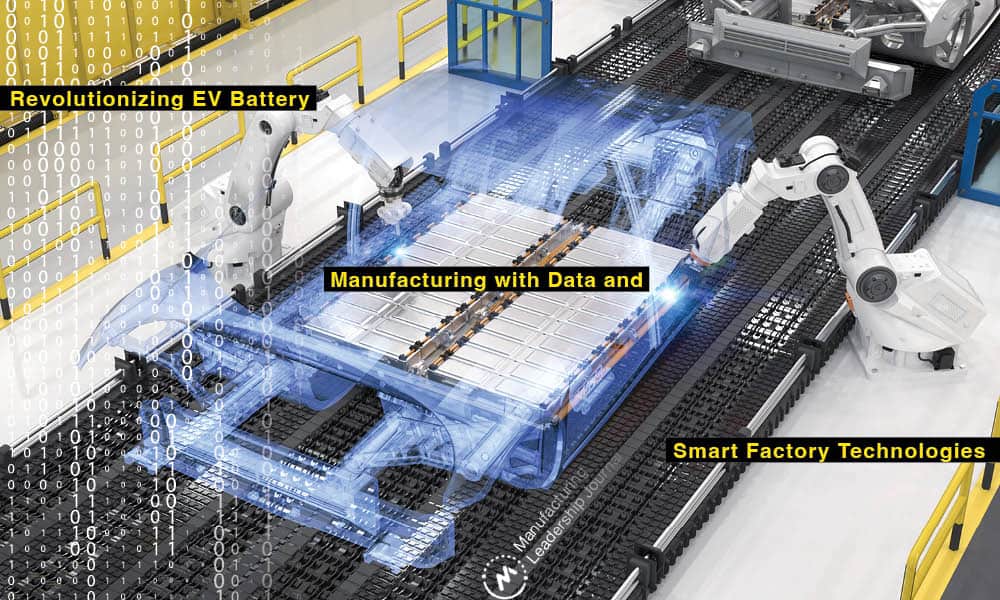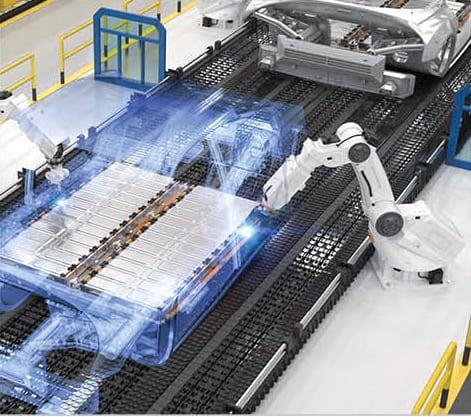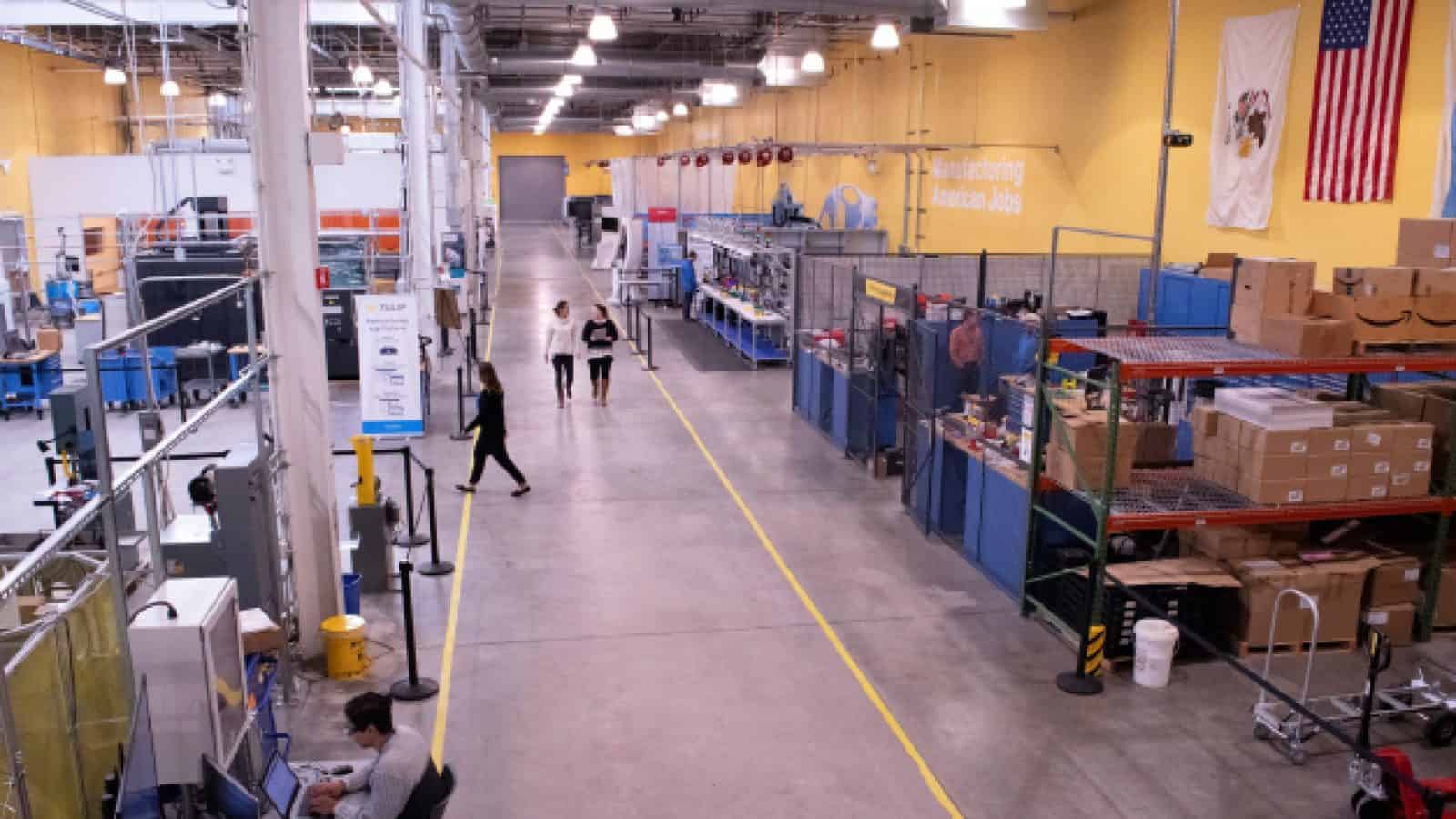Revolutionizing EV Battery Manufacturing with Data and Smart Factory Technologies

Manufacturers of electric vehicle batteries need to develop a data-driven operating model that is efficient and resilient with room to scale as EVs grow within the automotive industry.

TAKEAWAYS:
● Manufacturing 4.0 principles are informing the strategic direction of EV battery manufacturers, shaping their approach to personnel, digital transformation and supply chain.
● Data will give manufacturers greater understanding of the materials being used, helping them to find ways to innovate and improve efficiency and productivity.
● AI and blockchain technology can give battery manufacturers tools to more quickly adapt when setbacks occur, reducing waste and enhancing quality.
In an era when efficiency and innovation are paramount, the emergence of smart factories has marked a significant shift in manufacturing paradigms. These advanced manufacturing facilities leverage data, automation and technology to create more efficient and adaptable production processes. Central to this evolution is the integration of Manufacturing 4.0 strategies with overarching business objectives.
In the EV battery manufacturing sector, where precision and reliability are critical, leveraging transformative, data-driven technology is pivotal to surmounting business challenges and enhancing performance in battery manufacturing. The M4.0 best practices emerging for battery manufacturers also offer lessons for manufacturing in other sectors and industries.
EV Battery Market Still Evolving
The alignment of M4.0 strategies with business goals is crucial in the battery industry. Battery manufacturers need to explore business model innovation and find ways to drive peak profitability within their core business while simultaneously incubating new revenue streams. They need to not just retain customers, but also capture new ones and deliver an experience that is results-driven, personalized and responsive.
They also need to build resilience in their operating models, leveraging emerging technology to future-proof their supply chains. And EV battery manufacturers must enable talent on multiple levels, making it easier for employees to embrace digitalization and develop new capabilities.
Data-driven approaches underpin this integration, facilitating informed decision-making that streamlines production, improves output, and enhances metrics like yield and ramp-up times. Incorporating deep mineral and component analytics into these strategies allows for a more comprehensive understanding of materials and their impact on EV battery quality, performance and maintenance. This alignment not only boosts operational efficiency, but also fosters innovation in battery design and functionality, crucial for industries like the EV sector, which demands rapid production of high-quality batteries and aims to avoid future liabilities such as recalls.

“Battery manufacturers need to not just retain customers, but also capture new ones and deliver an experience that is results-driven, personalized and responsive.”
Regulation and standardization is another element that will shape the EV battery market. It could bring much-needed consistency and structure to a sector that is still seeking broader acceptance from consumers who need confidence that service for EVs will be as accessible and user-friendly as the structure they’ve used for internal combustion engine vehicles. At the same time, regulation and standardization can feel limiting to those with a more innovative approach to business and market growth.
A November 2023 Automotive News article addressed the benefits of such standardization “As standardization is achieved in areas such as connectors, chargers, regulations, and payment integration, OEMs and ecosystem partners will be better equipped to explore innovations that will further improve the customer experience, like contactless charging and seamless, transparent, automatic electricity billing.”¹
The article added that OEMs need to be ready for rapid changes in required battery capacity and vehicle range as the EV market continues to take shape.
Digital Transformation Requires Persistence
Digital integration is key in modernizing battery manufacturing processes and it can often be challenging. Companies need to determine where to start, how to scale and how to accelerate their efforts. Infrastructure, disparate systems, repeatability and commercial complexity are just a few trends that can impede digital transformation. It can also take time to break down silos and fully convey the value of the transformation. Manufacturers able to maintain focus, work through challenges and continue moving forward should begin to realize the value of their commitment.
Technologies like IoT and AI create a connected manufacturing environment, enabling manufacturers to monitor every aspect of the production line in real time. This extensive data collection and analysis leads to optimized operations, reduced waste and enhanced product quality. It enables manufacturers to create more agile, flexible and resilient processes that can help them better weather disruption – whether they can see it coming or not. Data provides tools to make those real-time assessments, evaluating a company’s current state, as well as its risks and opportunities, to inform decision-making for the next steps.
Specific technology deployment in battery manufacturing addresses challenges such as maintaining consistent quality and maximizing yield. AI algorithms predict equipment failures and identify potential quality issues in battery mixtures, reducing downtime and enhancing energy efficiency. Advanced analytics identify patterns in production data, leading to insights that drive process improvements. These interventions not only solve existing problems, but also enhance performance, leading to higher quality batteries and increased production rates.

“The implementation of autonomous robots and digital twins in manufacturing processes underscores the transformative impact of hybrid human-machine operations.”
A good example of these advances is found in electrode coating. By utilizing advanced sensors for real-time measurements of thickness and density, manufacturers can significantly enhance the quality of battery cells prior to the aging process. This ensures uniformity and optimal material composition, thus reducing the likelihood of defects post-aging. Additionally, in sample cell testing, the use of advanced analytics combined with holistic approaches and traceability — such as blockchain technology — enables manufacturers to identify suboptimal cells early in the process and avoid producing large quantities of suboptimal battery cells.
Moreover, the integration of this sensor data with ERP and MES systems creates a rich, multi-dimensional data landscape. This synergy enhances decision-making and operational agility, showcasing the essence of M4.0 in modern manufacturing.
In practice, battery manufacturers are leveraging these technologies in various ways. For instance, the implementation of autonomous robots and digital twins in manufacturing processes underscores the transformative impact of hybrid human-machine operations. These innovations enhance precision, efficiency, and adaptability, further revolutionizing the battery manufacturing sector.
Summary
The integration of M4.0 technologies in battery manufacturing is a gateway to the future of industrial production. As these technologies evolve, their potential to revolutionize battery manufacturing grows. We can anticipate advancements in collaborative robotics, enhanced digital twin capabilities, and sophisticated AI-driven analytics, contributing to smarter, more efficient, and sustainable battery production.
In summary, the integration of data-driven smart factory technologies in battery manufacturing is a game-changer. By embracing these advancements, manufacturers can overcome traditional challenges, improve operational efficiency, and set new benchmarks in quality and innovation. The future of battery manufacturing is bright, and it is undeniably powered by data.
About the author:

Felipe Smolka is Americas Automotive eMobility Leader at EY
The views reflected in this article are the views of the author(s) and do not necessarily reflect the views of Ernst & Young LLP or other members of the global EY organization.
